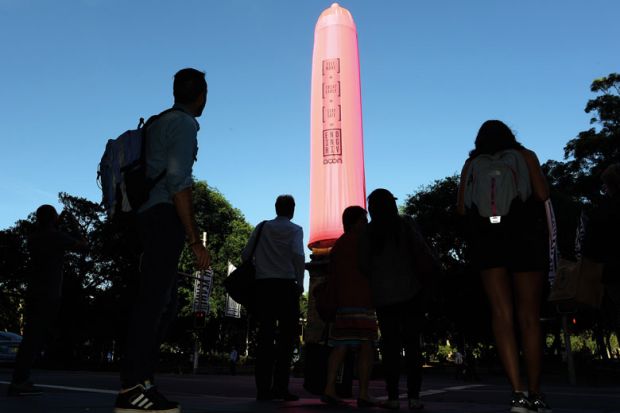A rising HIV caseload among Australia’s overseas students is undermining efforts to eliminate the disease while turning the international education dreams of hundreds of young foreigners into nightmares.
Health practitioners say universities need to boost awareness of HIV and other sexually transmitted infections as part of their duty of care to vulnerable students. They say subsidies for pre-exposure prophylaxis (PrEP), medications that reduce the chances of contracting HIV by up to 99 per cent, should also be extended to international students.
Australians can access PrEP for about A$30 (£16) a month through the Pharmaceutical Benefits Scheme, but foreigners pay up to five times as much if they import the pills – and around 30 times as much for over-the-counter supplies. Research suggests that international students’ concerns about the cost of PrEP, coupled with lack of awareness, are contributing to an uptick in infections.
Andrew Grulich, head of HIV epidemiology at the Kirby Institute at UNSW Sydney, said students featured prominently in a “remaining epidemic” of HIV concentrated in foreign-born gay and bisexual men. While infections among their Australian counterparts had fallen by about 70 per cent since 2014, he said, the international cohort had seen no such decline.
Professor Grulich told an Australian Science Media Centre briefing that uptake of the preventative drugs was high among inner-city Australian gays but low in other communities. “Very large numbers of foreign students in Australia, some of whom are men who have sex with men, cannot get access to subsidised PrEP,” he said.
The problem was exacerbated by stigma against homosexuality in students’ home countries, he added. “If people feel stigmatised, then they’re simply not going to seek out testing until they become very ill,” Professor Grulich said.
Australian HIV statistics generally do not distinguish international students from other migrants and visitors. Kirby Institute data show that the overseas-born proportion of the national HIV caseload has risen from less than 40 per cent a decade ago to around 50 per cent now.
In New South Wales, a magnet for international students, state health department figures show that overseas-born people dominate cases. About two-thirds of new HIV diagnoses involve people from overseas, mostly East and South-east Asia. Many have been in the country for four years or less, and they tend to be diagnosed late. Infections among overseas-born people dipped during the coronavirus pandemic but are now rising again.
Research released before the pandemic found that 61 per cent of the gay and bisexual Asian men diagnosed in Sydney and Melbourne between 2014 and 2017 had been overseas students. Testing and preventative interventions for international students should be prioritised, the authors concluded.
Belinda Meggitt, team lead for UNSW Sydney’s health promotions unit, said international students’ sexual health was an overlooked area in higher education despite potentially “profound” ramifications. HIV and unplanned pregnancies were both more prevalent among international students than among their Australian peers, she said.
“As universities, we have an opportunity to impact the lives of students in and out of class and to help them cultivate skills as global citizens. We also have a responsibility to keep them safe,” she said.
“In more permissive cultures like Australia, sexual initiation is occurring at younger ages. International students are no longer under the protective gaze of their parents, so it’s no surprise that many find themselves in tricky situations.”
Many international students arrive in Australia with limited sexual health education, often from countries where medical care is provided mainly in pharmacies or hospitals. They struggle with confusing regulations around health services for foreigners – especially those who change their visa statuses after arriving in Australia.
Ms Meggitt said cultural and legal factors amplified their bewilderment. Students from countries that outlawed homosexuality or compelled premarital abstinence were particularly disadvantaged. “They really don’t have the same tools to keep themselves healthy when they’re negotiating sexual encounters,” she said.
She added that universities needed to emphasise that sexual health tests were readily available, fully covered by their health insurance, and “part of being an adult in Australia. Just like you have checks for other health issues, you do sexual health tests.”
Focusing such messages around “identifiers” such as gay, queer or bisexual might suit locals but not international students, Ms Meggitt stressed. “It just doesn’t appeal to people who might not see themselves as belonging to any of those groups.”
Timing was also critical, she said. “When students first arrive, they’re not thinking so much about health or sex. Their focus is settling in, navigating their way around university and so on. The information needs to be available when they’re receptive to it. We tend to learn it when we need it.”
Register to continue
Why register?
- Registration is free and only takes a moment
- Once registered, you can read 3 articles a month
- Sign up for our newsletter
Subscribe
Or subscribe for unlimited access to:
- Unlimited access to news, views, insights & reviews
- Digital editions
- Digital access to THE’s university and college rankings analysis
Already registered or a current subscriber? Login










